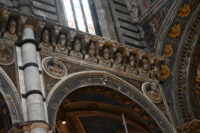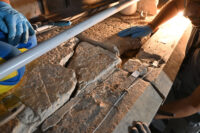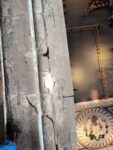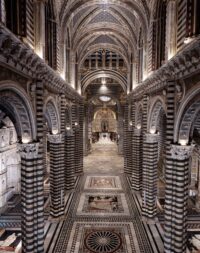 A section of the cornice overlooking the Presbytery of the Cathedral of Siena that is decorated with the busts of 171 popes was subject to an urgent intervention when cracks were discovered in two of the travertine slabs. A number of cracks, large and small, were spotted in June by a crew from the Acrobatic Monuments Construction company, specialists who use a double safety rope climbing technique to inspect and repair monuments. The cracks required immediate attention from the expert stone restorers of the Metropolitan Works of Siena, the municipal organization which oversees the cathedral.
A section of the cornice overlooking the Presbytery of the Cathedral of Siena that is decorated with the busts of 171 popes was subject to an urgent intervention when cracks were discovered in two of the travertine slabs. A number of cracks, large and small, were spotted in June by a crew from the Acrobatic Monuments Construction company, specialists who use a double safety rope climbing technique to inspect and repair monuments. The cracks required immediate attention from the expert stone restorers of the Metropolitan Works of Siena, the municipal organization which oversees the cathedral.
 Scaffolding was erected in two days, taking measures to protect the extraordinarily ornate marble inlay floor, which is usually covered for its own protection but happened to be in one of only two brief periods a year when it is exposed in all its glory to the visiting public. The urgency of the intervention and its own potential dangers were underscored when a 3.8 magnitude earthquake struck on the first day conservators were at work on the scaffolding 60 feet above the floor. All personnel were forced to dismount and wait for the all-clear. The next day work resumed on repairing the fractures and consolidating the damaged stone elements. The team was able to complete the work in four weeks. The scaffolding was dismantled in time for the last days of the floor’s uncovering.
Scaffolding was erected in two days, taking measures to protect the extraordinarily ornate marble inlay floor, which is usually covered for its own protection but happened to be in one of only two brief periods a year when it is exposed in all its glory to the visiting public. The urgency of the intervention and its own potential dangers were underscored when a 3.8 magnitude earthquake struck on the first day conservators were at work on the scaffolding 60 feet above the floor. All personnel were forced to dismount and wait for the all-clear. The next day work resumed on repairing the fractures and consolidating the damaged stone elements. The team was able to complete the work in four weeks. The scaffolding was dismantled in time for the last days of the floor’s uncovering.
 The Cornice of the Popes lines the central nave and choir of the Metropolitan Cathedral of Santa Maria Assunta, aka the Duomo of Siena. They were made by unknown artists between 1497 and 1502. The papal busts begin with Peter on the right of a bust of Christ. It runs clockwise chronologically with every successive pontiff concluding with Lucius III, pope between 1181 and 1185.
The Cornice of the Popes lines the central nave and choir of the Metropolitan Cathedral of Santa Maria Assunta, aka the Duomo of Siena. They were made by unknown artists between 1497 and 1502. The papal busts begin with Peter on the right of a bust of Christ. It runs clockwise chronologically with every successive pontiff concluding with Lucius III, pope between 1181 and 1185.
 The final pope was originally supposed to be the one before Lucius, Alexander III (1159-1181), because he was a native of Siena and consecrated the cathedral in 1179. Lucius was added after the bust of Pope John VIII (872-882) was removed because he was confused for one of the church’s mythical medieval scandals: the female Pope Joan, who, legend has it, reigned under the pontifical name John VIII from 855 to 857, only to be exposed when she gave birth on the streets of Rome after being thrown from her horse. The myth of Pope Joan had long been refuted when the cornice was made, but the legend persisted and the actual John VIII paid the iconographic price.
The final pope was originally supposed to be the one before Lucius, Alexander III (1159-1181), because he was a native of Siena and consecrated the cathedral in 1179. Lucius was added after the bust of Pope John VIII (872-882) was removed because he was confused for one of the church’s mythical medieval scandals: the female Pope Joan, who, legend has it, reigned under the pontifical name John VIII from 855 to 857, only to be exposed when she gave birth on the streets of Rome after being thrown from her horse. The myth of Pope Joan had long been refuted when the cornice was made, but the legend persisted and the actual John VIII paid the iconographic price.